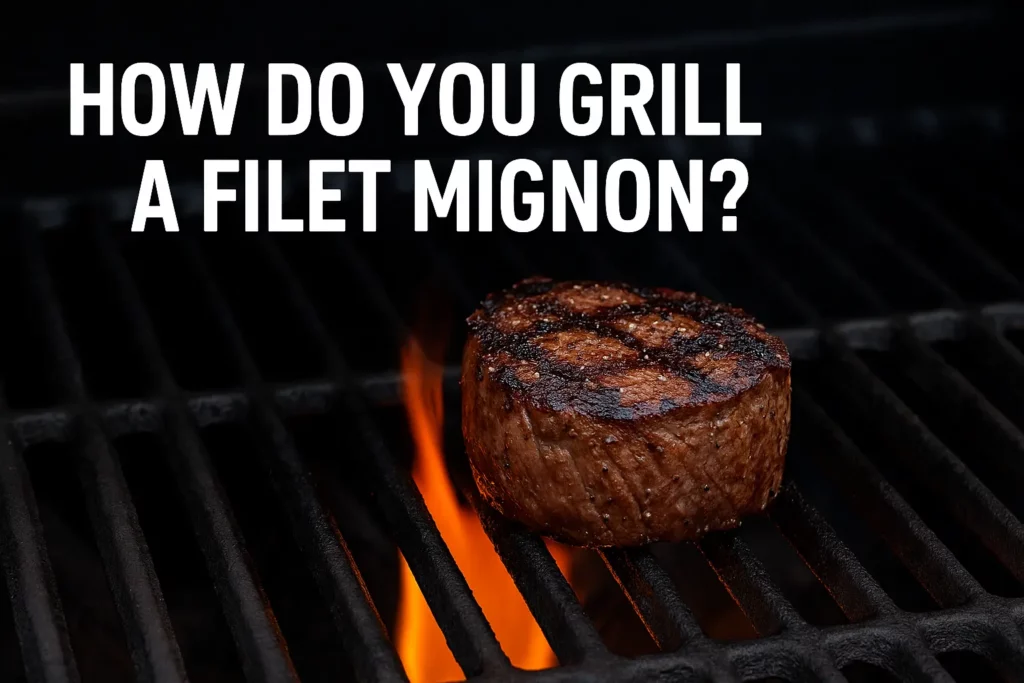This post may contain affiliate links. If you use these links to buy something we may earn a small commission. Thanks.
Grilling a filet mignon is like hosting a VIP guest at your backyard BBQ it deserves extra attention, the finest treatment, and just the right amount of heat. Filet mignon is often called the “king of steaks,” and rightfully so. It’s the most tender cut of beef, impressively lean, and carries an unmistakably luxurious bite.
But how do you grill a filet mignon to perfection? It’s not as simple as throwing it over open flames and hoping for the best. In this guide, we’ll walk you through everything from selecting the right cut to grilling it like a pro. Whether you’re a backyard beginner or an aspiring pitmaster, you’ll find everything you need to grill filet mignon with confidence.
What Is Filet Mignon?
Filet mignon comes from the tenderloin, a long, cylindrical muscle that runs along the spine of the cow. It’s a non-weight-bearing muscle, meaning it gets very little exercise—resulting in a buttery-soft texture you can cut with a fork.

This cut is known for:
- Tenderness: Easily the most tender steak on the market
- Leanness: Little to no marbling compared to ribeye or strip steaks
- Flavor: Mild and subtle best complemented with minimal seasoning or sauces
It’s also one of the most expensive cuts, often ranging from $25 to $45 per pound, depending on grade and source.
Choosing the Right Filet Mignon
Not all filet mignon is created equal. When selecting your steak, consider the following:
1. USDA Grade
- Prime: Best quality, excellent tenderness, and some marbling—ideal for grilling.
- Choice: A great alternative at a slightly lower price.
- Select: Budget-friendly but may lack the texture and richness of higher grades.
2. Thickness
- For grilling, choose steaks that are at least 1.5 to 2 inches thick. Thinner steaks cook too quickly and don’t allow for proper searing and interior doneness control.
3. Bone-In vs. Boneless
- Most filet mignons are boneless, but bone-in versions (sometimes called tenderloin steaks) offer a bit more flavor and presentation appeal.
4. Fresh, Dry-Aged, or Frozen
- Dry-aged filets have more concentrated flavor and a firmer texture.
- Fresh is always best, but if frozen, ensure a full defrost in the fridge for 24 hours before grilling.
Preparing the Filet Mignon for the Grill
1. Thawing (If Frozen)
Always thaw frozen steaks in the refrigerator, not at room temperature. For best results, let them sit in the fridge for 24 hours and then rest at room temperature for 30 minutes before grilling.
2. Trimming
Your butcher should remove the silver skin, but double-check. Trim any excessive fat that won’t render well on the grill.
3. Seasoning
You don’t need to do much. Filet mignon shines with simplicity.
- Classic Method: Kosher salt + freshly cracked black pepper.
- Optional Enhancements:
- Garlic powder
- A light brushing of olive oil
- Fresh herbs like rosemary or thyme
Avoid marinades—they overpower the meat’s natural taste. If you want a flavor boost, prepare a compound butter with herbs, garlic, and lemon to melt over the steak after grilling.
Tools and Equipment You’ll Need
- Grill: Gas, charcoal, or pellet will work. Charcoal provides the best sear and flavor.
- Meat thermometer: Essential for precision cooking.
- Tongs: Never pierce the steak with a fork!
- Timer: To keep track of searing and resting times.
- Cast Iron Skillet (optional): For reverse searing or if you want an even crust.
Grilling Methods
A. Direct High-Heat Method (Traditional Grill Method)
Perfect for 1.5–2 inch filets.
Steps:
- Preheat your grill to 450°F–500°F.
- Clean and oil the grates.
- Place filet mignons over direct heat.
- Sear for 2–3 minutes per side, using tongs to rotate for diamond grill marks.
- Move the steak to indirect heat and close the lid.
- Cook to your desired internal temperature (see chart below).
- Remove from heat and rest for 5–10 minutes.
B. Reverse Sear Method
Best for thicker filets (2 inches+). This method allows even cooking and a perfect crust.
Steps:
- Preheat your grill to 275°F–300°F.
- Place filets on indirect heat and slowly cook until the internal temp is 10–15°F below your desired doneness.
- Remove steaks and crank the grill up to high (500°F+).
- Sear each side for 1–2 minutes for a crusty exterior.
- Let the steak rest, then serve.
Doneness Chart & Internal Temperatures
Using a meat thermometer ensures accuracy. Here’s a quick reference:
| Doneness | Pull Temp (°F) | Final Temp (°F) |
|---|---|---|
| Rare | 115–120°F | 120–125°F |
| Medium Rare | 120–125°F | 130–135°F |
| Medium | 130–135°F | 135–140°F |
| Medium Well | 140–145°F | 145–150°F |
| Well Done | 150–155°F | 155°F+ |
Tip: Filet mignon is best served medium rare. Going beyond medium can dry it out due to its low fat content.
Resting and Serving the Filet Mignon
After grilling, let the steak rest for 5 to 10 minutes, loosely tented with foil. This allows the juices to redistribute, preventing dryness when you cut into it.
Serving Suggestions:
- Top with compound butter (garlic, rosemary, lemon zest)
- Drizzle with red wine reduction
- Serve with sides like:
- Roasted asparagus
- Parmesan mashed potatoes
- Grilled mushrooms
- Balsamic-glazed Brussels sprouts
Pro Tips for Grilling the Perfect Filet Mignon
- Oil the grates to prevent sticking and ensure those iconic grill marks.
- Use tongs, not a fork. Piercing the meat causes juices to escape.
- Don’t overseason. Filet mignon is best enjoyed with simple seasoning.
- Use a meat thermometer—eyeballing temperature is risky for such an expensive cut.
- Let it come to room temperature before grilling. Cold meat seizes up and cooks unevenly.
Common Mistakes to Avoid
- Grilling Cold Meat
- Filet should sit out for 30 minutes before hitting the grill.
- Overcooking
- This lean cut dries out fast. Always track the internal temperature.
- Skipping the Rest
- Resting is critical for juiciness. Don’t skip it.
- Using Low Heat
- You need high, direct heat for the best crust.
- Buying Poor-Quality Meat
- Avoid lower grades and unfamiliar sources. Pay for quality it makes a difference.
Conclusion
Grilling a filet mignon may feel intimidating at first, but with the right techniques, tools, and timing, you can create a restaurant-worthy steak in your own backyard.
To recap:
- Start with a high-quality, thick filet
- Season simply and avoid overpowering flavors
- Use either high heat or the reverse sear method for optimal texture
- Monitor internal temperatures with a thermometer
- Always rest before slicing
Whether you’re celebrating a special occasion or just want to treat yourself, filet mignon is worth the effort. Grilled right, it’s pure steak perfection.
